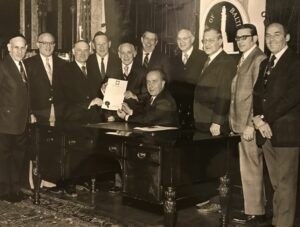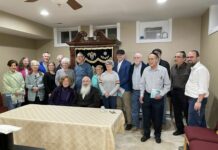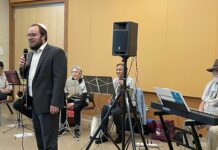B’nai Israel: The Downtown Synagogue boasts one of the longest histories of any synagogue in the Baltimore area, having been founded shortly after the Civil War.

The synagogue is currently gearing up to honor that history with a special celebration for its 150th anniversary, including a special Roots & Return Shabbaton.
The Shabbaton will see prominent Orthodox scholars and community figures, including Scholar-in-Residence Zev Eleff and Beth Tfiloh Congregation Cantor Emeritus Chazzan Avraham Albrecht, discussing B’nai Israel’s storied history and challenges that the Orthodox community is currently facing.
While the date of B’nai Israel’s exact founding is unclear, its first board of trustees was established and its certificate of incorporation was signed in 1873. As a result, 1873 is considered the synagogue’s beginning, though it was originally known as Russian Congregation B’nai Israel of Baltimore City.
This information was compiled by Fred Shoken, a local historian and congregant with a background in historical preservation, who has researched much of B’nai Israel’s history. Shoken first got involved in studying the synagogue’s history 20 years ago. At the time, B’nai Israel was planning a celebration for its 130th anniversary, and synagogue staff requested Shoken write up a brief history for the website.
Shoken and Eleff will be leading a historic walking tour of Lloyd Street for the Roots & Return Shabbaton.
“At the time [in 1873], most of the shuls in Baltimore were German shuls,” Shoken said. “But many of the German Jews moved out to start a movement in the Northwest, and the Russian and Eastern European Jews took over their buildings and their shuls. So for many years, there was a split between the German and Russian congregations.”
Like many synagogues, B’nai Israel was initially created when congregants from another synagogue disagreed with its teachings and moved to form their own. In this case, that earlier synagogue was named Bikur Cholim (not to be confused with the volunteer organization of the same name). B’nai Israel soon took up residence in Bikur Cholim’s former building. In 1895, the congregation moved to its current building, which had formerly served as Chizuk Amuno Congregation’s location on Lloyd Street.
“In general, Jews have been upwardly mobile, so they always move to new areas,” Shoken said. “To remain in one place for that long is truly unique.”
There are very few synagogue buildings still standing from that era, with Shoken estimating that only around 200 remain in the country. Many are not used as synagogues anymore, either, so the number that have remained consistently active is even smaller.
B’nai Israel is also notable for being the “sole Jewish outpost in the wilderness,” as Shoken put it, after a wave of Jews moved away from East Baltimore following World War II. Between 1945 and 1974, 21 East Baltimore congregations disbanded, moved or merged with other congregations. This caused many of the Jewish people remaining in the area to migrate to B’nai Israel, and this proved to be a great boon to the congregation as its community grew rapidly over the years.
Shoken credits much of the synagogue’s persistence during this difficult time to then-Rabbi Samuel Pliskin, who led B’nai Israel through a particularly dire time for American Jews after he was appointed in 1939. Despite B’nai Israel’s status as an Orthodox synagogue, Pliskin, who was the rabbi for nearly 40 years, welcomed congregants of all levels of observance.
As noted in Shoken’s write-up on the synagogue’s history, Pliskin once said that “when a long-lost child comes home, parents do not ask questions. No investigating. No discussing. The Mother and Father always care.”
Pliskin’s influence on the congregation was so great that people began referring to it as “Pliskin’s shul.”
“As a historic synagogue, there’s a sort of spirit to it, a kind of ruach,” Shoken said. “For 129 years, people have been praying in the same building, and that gives it a certain character.”







